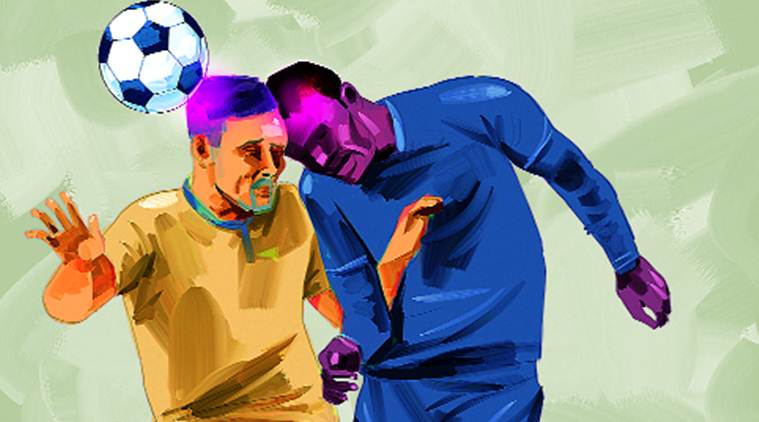Headers highlight football’s dangerous side
Though widely believed that accidental knocks to the head are the main culprit behind leaving a footballer dazed, research shows the actual practice of hitting the ball with the head puts one at risk.
 According to a research conducted by the Albert Einstien College of Medicine, headers in football are one of the main causes of concussion symptoms. Illustration: CR Sasikumar
According to a research conducted by the Albert Einstien College of Medicine, headers in football are one of the main causes of concussion symptoms. Illustration: CR Sasikumar
National Football League (American football) retirees have been asked by a federal judge to register for a concussion settlement that could cost the league $1 billion over 65 years, while the National Hockey League (ice hockey) is disputing research — in order to avoid compensation — that shows its players have suffered because of game-related concussion. But these are not the only two sports which have dealing with head injuries to players. Headers in football — one of the staples of the beautiful game — is being identified as a leading cause for concussion symptoms. Though widely believed that accidental knocks to the head are the main culprit behind leaving a footballer dazed, research shows the actual practice of hitting the ball with the head puts one at risk.
Why is the focus on headers?
A recent study has reaffirmed that headers in football can cause concussion symptoms and further long-term consequences. According to the research by Albert Einstein College of Medicine, players who frequently head the ball are three times more likely to have moderate (pain and dizziness) to severe (player being knocked out) symptoms than players who don’t resort to the technique. Coupled with previous findings that it affects the brain function almost immediately, the report has again put headers under scanner.
Can there be a ban on headers?
Although banning one of the staples of the sport remains a far-fetched notion, it has been done before. The US Soccer Federation introduced new safety initiatives in November 2015 in response to a class-action lawsuit that claimed the federation, Fifa and American Youth Soccer Organization were negligent when it came to head injuries. In the United States, players aged 10 and younger are prohibited from heading in practice games while 11 to 13-year-olds are restricted to a maximum of 30 minutes of heading training per week. While Fifa has ruled out such a ban time and again, the Professional Footballers’ Association (PFA) last year urged Football Association (FA) to take the necessary steps.
Have headers ever caused a concussion?
Maybe not directly, but aerial duels have. Incidents of players banging heads against each other or the goalposts are too frequent for comfort. The 2014 World Cup was notorious for the handling of such cases, including the final which saw a 23-year-old Christoph Kramer clashing with Argentina’s Ezequiel Garay and later asking the referee “is this the final?”
What do the guidelines say?
‘If in doubt, sit them out.’ According to guidelines issued by FA in 2015, all Premier League players undergo a pre-season neurological assessment as part of their annual medical check-up. Any player suffering a head injury must leave the pitch and the club doctor must decide if the player is capable of continuing — not the team manager or coaches. But it hasn’t stopped visibly-disoriented players from resuming the game, only to be substituted minutes later, as was the case with Anthony Martial during Manchester United’s game against Watford last September.
How are other sports dealing with it?
While boxing and medical community are still undecided whether headgear prevent concussions or cause them, the Canada federation again made head protection mandatory this week. AFL and NFL are thinking of putting accelerometers in every player’s helmet to better monitor the cases; the latter has also announced new guidelines for the kickoff returns.
What about a non-contact sport?
Cricket seems to be making progress in tackling this issue. Having faced the worst possible scenario, Cricket Australia have been at the forefront of concussion safety. CA (and later New Zealand Cricket) trialled a concussion sub rule for this season’s Matador Cup and Big Bash League.
Interestingly, it hasn’t been permitted in the Sheffield Shield — the competition which saw the Phil Hughes tragedy — because ICC rejected the proposal to allow concussion substitutes in first-class cricket. Australia coach Darren Lehmann and captain Steven Smith urged the ICC to adopt the protocol, especially after their opener Matt Renshaw was ruled out after being struck on the helmet twice in two days during the opening Test against Pakistan. ICC amended the guidelines to ensure all batsmen wore British Standard BS7928:2013-compliant helmets, which are tested, have a narrower gap between the peak and the grille of the helmet and are not adjustable on either side, thereby reducing the risk of a ball entering through the opening in the helmet. CA are also looking to introduce concussion sensors in the helmets.

































